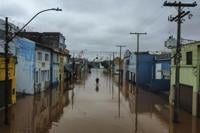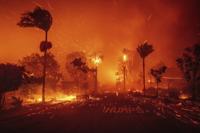In sweltering Brazil, flooding killed dozens of people and paralyzed a city of about 4 million people. Voters and politicians in India, amid national elections, are fainting in heat that hit as high as 115 degrees (46.3 degrees Celsius).
A has closed schools in the Philippines, killed people in Thailand and set records there and in Indonesia, Malaysia, the Maldives and Myanmar. Record temperatures — especially at night when it just won't cool down — have hit many parts of Africa. Flooding devastated Houston, and the United States as a whole just had its for the month of April.
In a world growing increasingly accustomed to wild weather swings, the last few days and weeks have seemingly taken those environmental extremes to a new level. Some climate scientists say they are hard pressed to remember when so much of the world has had its weather on overdrive at the same time.
“Given that we've seen an unprecedented jump in global warmth over the last 11 months, it is not surprising to see worsening climate extremes so early in the year,” said University of Michigan environment dean Jonathan Overpeck. “If this record pace of warming continues, 2024 will likely be a record year of climate disasters and human suffering.”
When the world is warmer, it is likely to have more extreme weather and climate events, including record heat and rainfall, scientists say. And is also changing weather patterns, leading to rainy and hot systems stalling over areas and the jet stream meandering, said Alvaro Silva, a climate scientist at the World Meteorological Organization.
Adding to the stronger effects of human-caused climate change is a now-weakening El Nino — a natural warming of parts of the central Pacific that changes weather worldwide — that came on the heels of a three-year La Nina, its cool counterpart, Silva said.
Scientists also pointed to hot oceans as a potential factor in the weather extremes.
This all comes as the world just finished its 11th record-breaking hot month in a row, the European climate service Copernicus reported Wednesday.
The average global temperature of 59 degrees Fahrenheit (15 degrees Celsius) in April beat the old record from 2016 by a quarter of a degree (0.14 degrees Celsius). Copernicus’ data set goes back to 1950, while other climate monitoring agencies go back to 1850 but have yet to report April calculations.
Last month was 1.58 degrees Celsius (2.84 degrees Fahrenheit) warmer than the pre-industrial late 19th century. The world in 2015 adopted a goal of limiting warming to 1.5 degrees Celsius above pre-industrial times, but it mostly applies to being that warm for a decade or more, not a month.
While several factors play a role in this recent spate of extremes, “climate change is the most important one,” Silva said.
The trouble is that the world has adapted to and constructed cities designed for 20th century temperatures and rainfall, but climate change brings more heat and downpours, said Andrew Dessler, a Texas A&M University climate scientist.
“We're departing the climate of the 20th century right now and we just can't handle these events,” Dessler said. “So they're getting slightly more extreme, but they're passing our ability to handle them.”
Texas Tech climate scientist Katharine Hayhoe, chief scientist for the Nature Conservancy, said more extremes in more places are overlapping.
“Climate change is loading the weather dice against us in every part of the world,” Hayhoe said. “What this means is that it is increasing not only the frequency and severity of many weather extremes, but also that the risk of compound events is increasing.”
In just the first five days of May, 70 countries or territories broke heat records, said climatologist Maximiliano Herrera, who tracks temperature records across the world.
Nandyala and Kadapa in India's southern state of Andhra Pradesh set an all-time high at 115 degrees (46.3 Celsius), Herrera said.
Nitin Gadkari, a federal minister, fainted during campaigning in the western Indian state of Maharashtra.
“Heatwaves in India are by far the deadliest type of extreme weather events. At the same time, they are the type of extremes most strongly increasing in a warming world,” said climate scientist Friederike Otto in a statement earlier this week.
This week in Southeast Asia, “it was the hottest May night ever,” Herrera posted on X (formerly Twitter). Parts of Thailand didn't drop below 87.6 degrees (30.9 Celsius).
In late April, parts of northern Thailand hit 111 degrees (44 Celsius), while Chauk township in Myanmar's hottest region hit a record 118.8 degrees (48.2 Celsius).
Many African nations are also facing scorching heat. Herrera said it hit 117.5 degrees (47.5 Celsius) in Kayes, Mali. The capital of Niger had its hottest May night and Burkina Faso's capital had its hottest night for any month. In Chad, in north central Africa, temperatures were expected to linger above 114 degrees (45.6 Celsius) all week.
The felt across West Africa last month was linked to human-caused climate change, according to scientists at the World Weather Attribution group.
In Mexico's Ciudad Altamirano, the temperature neared 115 degrees (46 Celsius) with record heat all over Latin America, Herrera said. Bolivia had its hottest May night on record and Brazil its hottest day in May.
The record-setting Brazil heat that stifled huge cites such as Sao Paulo also kept a rainstorm from moving over the country's south, turning it deadly, according to Francisco Aquino, a climatologist at the Federal University of Rio Grande do Sul.
There also was a massive influx of humidity from the Amazon's so-called flying rivers, or air currents that carry water vapor, Aquino explained. “These caused clouds to generate extreme rainfall,” he said.
The Southern State of Rio Grande do Sul is reeling from the worst flood on record, with at least 90 people dead, nearly 204,000 displaced and 388 municipalities impacted, according to local authorities
In Porto Alegre, a metropolitan area with over 4.4 million inhabitants, the waters took over downtown, the international airport and several neighborhoods. Authorities said it will take days for the water level to recede.
Houston is still trying to dry out out that required more than 600 people to be rescued from flooding across Texas, including 233 people in Houston. Just northeast of Houston, about 23 inches (58 centimeters) fell.
Meanwhile, April brought the heaviest rains ever recorded to the United Arab Emirates, flooding portions of major highways in the desert kingdom and Dubai International Airport, the world’s busiest hub for international travel.
—-
Borenstein and Naishadham reported from Washington, Arasu from Bengaluru, India, and Maisonnave from Brasilia, Brazil.
__
Read more of AP’s climate coverage at
___
Follow Seth Borenstein on X at , Suman Naishadham at and Sibi Arasu at
______
The Associated Press’ climate and environmental coverage receives financial support from multiple private foundations. AP is solely responsible for all content. Find AP’s for working with philanthropies, a list of supporters and funded coverage areas at .








































